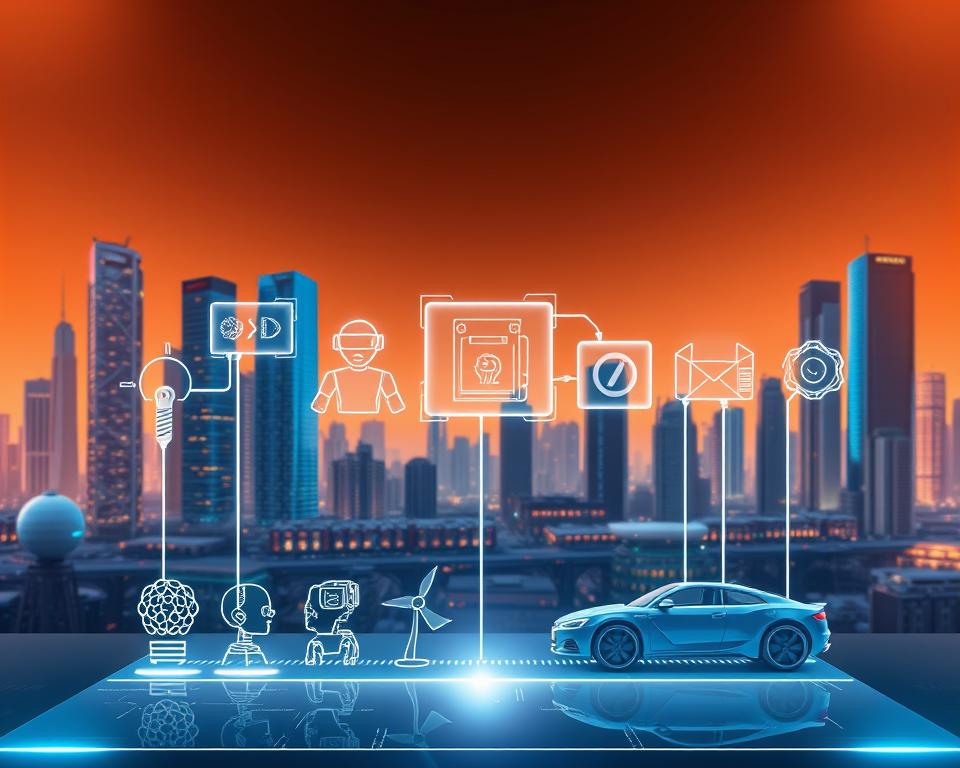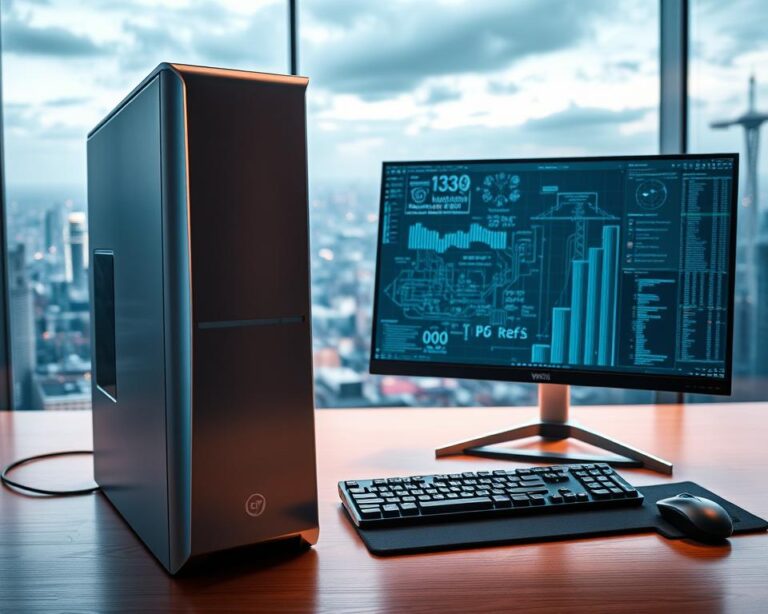
What Are the 7 Main Types of Technology?
Did you know that as of 2023, over 5 billion people around the world are using the internet, showcasing the profound impact of technology on our daily lives? This staggering statistic underscores the importance of understanding what are 7 types of technology that shape our reality. As technological advancements continue to unfold, it becomes essential to explore major technology classifications. This article will delve into the seven key categories: Information Technology, Communication Technology, Consumer Electronics, Medical Technology, Transportation Technology, Energy Technology, and Manufacturing Technology. By gaining insights into these types of modern technology, we can better appreciate their roles and how they influence society and the economy. Let’s embark on this journey to uncover the advanced technology types that are integral to our world.

Key Takeaways
- Over 5 billion internet users highlight the impact of technology.
- Understanding technology classifications helps navigate daily life.
- There are seven main types of technology shaping our world.
- Each type plays a unique role in society and the economy.
- Exploring innovations enhances our ability to adapt and thrive.
Introduction to Technology
The introduction to technology reveals the fascinating evolution of tools and systems that empower human activity. Throughout history, technology has transformed from simple tools to complex digital systems that form the backbone of modern society. Today, it permeates almost every facet of our lives, shaping how we communicate, work, learn, and recreate.
As we explore the technology landscape, it becomes clear that technology is not a monolith. It consists of diverse technology categories, each serving unique purposes and addressing distinct needs. From information technology that manages data to medical technology that enhances healthcare, each category plays a pivotal role in advancing innovation.
Understanding these categories allows us to appreciate how interconnected our experiences have become through technology. The impact of technology on our daily lives invites us to consider not only its benefits but also the implications of its pervasive presence. This knowledge sets the stage for discussing the various types of technology in more detail.

What Are 7 Types of Technology
Technology encompasses a wide range of tools, systems, and methodologies that contribute to solving problems or enhancing processes. When discussing what are 7 types of technology, understanding the concept of defining technology becomes crucial. This definition can vary depending on context, but at its core, technology is an application of scientific knowledge for practical purposes. It spans from simple tools used in daily life to complex systems that drive industries forward.

Recognizing essential technology categories aids individuals and organizations in navigating a tech-driven landscape. In a world where advancements occur rapidly, knowledge of the various types of technology is fundamental. This understanding enables informed decisions, whether at home, in schools, or in business environments. Engaging with the diverse aspects of technology can help individuals leverage these tools effectively, ultimately enhancing both personal and professional life.
Defining Technology
Defining technology involves looking beyond gadgets and focusing on processes and systems that facilitate improvement. It plays a pivotal role in various spheres of life, such as healthcare, education, and engineering. Each field utilizes distinct forms of technology tailored to its specific needs, driving innovation and efficiency.
Importance of Understanding Different Types
Recognizing the different types of technology enhances one’s ability to make educated choices in a rapidly evolving environment. Understanding the key functionalities and applications of these essential technology categories can lead to better integration of technological solutions in daily activities. Whether adopting new software or upgrading equipment, a solid grasp of various technologies leads to increased adaptability and effectiveness.
Information Technology
Information Technology (IT) plays a pivotal role in managing and processing data using computers and software. This information technology overview highlights the various components that make IT a cornerstone of modern business and daily life. Its influence extends across multiple sectors, with numerous advancements shaping the landscape of digital interactions.
Overview of Information Technology
At the heart of information technology lies the ability to collect, store, and disseminate information efficiently. IT encompasses a wide range of systems and methodologies that facilitate communication and data management. Key elements include:
- Cloud Computing
- Data Storage Solutions
- Cybersecurity Measures
- Networking Systems
These components serve various purposes and offer diverse functionalities within different organizations, ensuring that they remain competitive and agile in an ever-evolving market.
Key Applications of Information Technology
The applications of information technology extend far beyond simple data management. They include advanced technologies like artificial intelligence and machine learning, which enhance operational efficiencies and decision-making processes in industries such as finance, healthcare, and logistics. Understanding different types of technology within IT helps organizations leverage these applications effectively:
| Application | Description | Industry Impact |
|---|---|---|
| Cloud Computing | Delivery of computing services over the internet | Reduces costs and increases flexibility |
| Cybersecurity | Protection of systems from cyber threats | Safeguards sensitive information |
| Data Storage | Storage solutions for data preservation and access | Ensures data availability and reliability |
| Artificial Intelligence | Simulation of human intelligence processes | Enhances automation and analysis capabilities |
As organizations increasingly integrate IT into their operations, understanding these key applications allows them to optimize their resources and drive innovation.

Communication Technology
Communication technology has undergone significant transformation over the decades, shaping how people interact and share information. The evolution of communication technology has moved from early innovations like the telegraph and telephone to the advanced digital platforms and social media that dominate our daily lives. Each phase brought forth popular technology types that have redefined communication norms and practices.
Evolution of Communication Technology
The journey of communication technology began with the invention of the telegraph in the 19th century, revolutionizing long-distance communication. This was followed by the telephone, which allowed for voice conversations across vast distances. The advancements did not stop there; the emergence of the internet in the late 20th century marked a pivotal moment. It introduced email, instant messaging, and various social media platforms, drastically changing how humans engage with each other.
How Communication Technology Impacts Society
The impact of communication technology on society cannot be overstated. It has transformed not just personal interactions but also business operations and government functionality. Access to vast amounts of information has increased significantly, enhancing awareness and knowledge. Social dynamics have shifted as well, as communication technology fosters global connectivity, bringing cultures closer than ever. This accessibility embodies the essence of modern living, showing how integral it has become in shaping cultural and societal structures.

Consumer Electronics
Consumer electronics represent a significant part of our daily lives, bridging the gap between technology and comfort. The devices within this sector not only provide entertainment but also enhance productivity, connectivity, and convenience. A broad overview reveals various consumer electronics categories that have become indispensable in modern living.
Popular Categories of Consumer Electronics
- Smartphones: Essential for communication and connectivity, smartphones are one of the leading consumer electronics categories, offering apps and features that cater to personal and professional needs.
- Laptops: These portable computers provide flexibility for work and play, integrating powerful processing capabilities within a compact frame.
- Smart Home Appliances: Devices such as smart thermostats and voice-activated assistants streamline household tasks, marking a transformative shift in everyday technology.
- Wearable Tech: From fitness trackers to smartwatches, this category promotes health monitoring and allows users to stay connected on the go.
The Role of Consumer Electronics in Everyday Life
Consumer electronics play a pivotal role in enhancing our day-to-day interactions and experiences. They support essential technology categories that facilitate communication, work, and entertainment. For instance, smartphones enable instant connectivity with family and friends, while smart home appliances simplify household management, making chores less time-consuming. Additionally, laptops serve as versatile tools, empowering individuals to work remotely or enjoy leisure activities. The integration of these devices into everyday technology has revolutionized how we engage with the world around us.
Medical Technology
Recent years have witnessed remarkable advancements in medical technology, transforming healthcare practices and improving patient outcomes. Innovative developments in this field have led to smarter solutions that enhance diagnosis, treatment, and monitoring. From telemedicine platforms that allow remote consultations to sophisticated robotic surgeries, the landscape of healthcare has evolved significantly.
Advancements in Medical Technology
One of the most significant breakthroughs includes the integration of artificial intelligence (AI) in diagnostics, facilitating earlier and more accurate detection of diseases. Technologies such as 3D printing have also created opportunities for personalized medical implants and prosthetics, catering to individual patient needs. Furthermore, advancements in portable imaging devices allow for quicker assessments in various settings, promoting timely medical interventions.
Essential Medical Devices and Techniques
Many essential medical devices and techniques have emerged, driving improvements in patient care. Key examples include:
- MRI Machines: Provide detailed images of organs and tissues, aiding in accurate diagnosis.
- Pacemakers: Regulate heartbeats, significantly enhancing the quality of life for individuals with heart disorders.
- Wearable Health Monitors: Enable continuous health tracking, empowering patients to manage their wellbeing actively.
These medical devices exemplify the diverse types of modern technology that have reshaped healthcare, making it more responsive and effective. Continuous research and development in these areas promise further enhancements, ensuring that healthcare evolves to meet future challenges.
Transportation Technology
The landscape of transportation technology continues to transform, driven by innovative solutions aimed at enhancing safety, efficiency, and sustainability. As urbanization escalates and populations grow, the demand for modern transport solutions rises sharply. Many industries now focus on transportation technology innovations that not only streamline logistics but also improve environmental outcomes.
Innovations in Transportation Technology
Electric vehicles represent a significant shift in how we perceive personal and commercial transportation. These vehicles offer a clean alternative to traditional gasoline-powered options, reducing carbon emissions and dependency on fossil fuels. Similarly, autonomous driving systems are redefining transportation by introducing self-driving technology that promotes safer roadways. These systems are not just futuristic dreams; they are rapidly becoming a reality, demonstrating remarkable advancements in artificial intelligence and machine learning.
High-speed rail systems are another breakthrough in modern transport solutions. By connecting major cities with swift transit options, these systems enhance mobility while minimizing travel times. Such advancements play a pivotal role in reducing congestion on roads and lowering greenhouse gas emissions associated with air travel.
The logistics sector is also experiencing significant technological advancements in transportation. Drone deliveries are becoming more commonplace, providing quicker solutions for shipping goods directly to consumers’ doorsteps. Smart traffic management systems utilize real-time data to optimize traffic flow, thereby reducing congestion and improving overall urban mobility.
As these transportation technology innovations emerge, they illustrate a clear commitment to sustainable goals. The integration of cutting-edge technologies continues to shape the way we travel, heralding an era of smarter and eco-friendly transportation systems.
Energy Technology
Energy technology plays a crucial role in transforming our energy landscape. Various energy technology types focus on harnessing, managing, and utilizing energy resources efficiently. Among these, renewable energy technologies stand out, particularly solar, wind, and hydropower. Each of these technology categories contributes to a more sustainable energy future.
Types of Energy Technology
Different energy technology types provide diverse solutions tailored to meet growing global demands. Key examples include:
- Solar Technology: Utilizes the sun’s rays to generate electricity through solar panels.
- Wind Technology: Harnesses wind power via turbines, converting it into electricity.
- Hydropower: Uses water flow, such as rivers or dams, to produce energy efficiently.
- Geothermal Energy: Extracts heat from beneath the Earth’s surface for power generation.
- Biomass Energy: Turns organic materials into fuel, reducing waste and generating energy.
Benefits of Renewable Energy Technologies
The rise of renewable energy technologies brings numerous advantages. Some benefits include:
- Reduction of carbon footprints, directly contributing to environmental sustainability.
- Minimization of dependence on fossil fuels, promoting economic resilience.
- Enhancement of energy independence, empowering communities and nations.
- Creation of job opportunities within growing sectors focused on renewable solutions.
Advancements in energy storage and efficiency are key in supporting the growth of renewable energy technologies. Developing innovative technologies ensures a balanced energy supply, further enabling nations to transition to more sustainable systems.
Manufacturing Technology
Manufacturing technology has rapidly evolved, embracing modern manufacturing techniques that revolutionize production processes. Industries today focus on automation, additive manufacturing, and smart manufacturing systems to enhance efficiency and flexibility. These advanced technology types not only streamline operations but also reduce waste and improve customization capabilities.
Modern Manufacturing Techniques
One prominent example of modern manufacturing is automation, where robots and AI systems take over repetitive tasks, allowing human workers to focus on more complex issues. Companies like Tesla implement these techniques to scale production and enhance quality control, setting new industry standards.
Additive manufacturing, commonly known as 3D printing, represents another leap in manufacturing technology. This method allows for the creation of complex parts directly from digital files, significantly cutting down material waste and production time. Industries ranging from aerospace to healthcare utilize 3D printing to innovate and enhance product designs.
Smart manufacturing systems integrate IoT technology, enabling real-time monitoring and data analytics in the manufacturing process. This approach facilitates informed decision-making, optimizing supply chains and production schedules. Firms such as Siemens leverage these systems to maintain competitiveness and drive innovation.
Overall, these modern manufacturing techniques highlight the industry’s shift toward integrating advanced technology types. By adopting these innovative solutions, manufacturers not only increase efficiency but also stay ahead in a competitive market.
Conclusion
In summary of technology types, we have explored a wide array of categories, each influencing our daily lives in profound ways. Understanding the distinct areas—ranging from information to transportation technology—provides valuable insights into how these innovations interconnect and contribute to a more efficient society. A comprehensive reflection on diverse technology categories reminds us that they are not isolated; rather, they work synergistically to drive human progress.
The future of technology promises to unveil even more exciting advancements, with trends like artificial intelligence and renewable energy leading the charge. As technologies evolve, they continue to reshape industries and redefine possibilities, impacting everything from healthcare to communication. Staying informed about these developments is crucial, as they pave the path for future innovations that will undoubtedly transform our world.
As we conclude this exploration, it’s evident that the ever-changing landscape of technology will require ongoing engagement and curiosity. Whether it’s embracing new consumer electronics or monitoring medical advancements, we must remain adaptable and informed. Embracing this evolution not only enhances our lives but also prepares us for the extraordinary future that technology holds.



